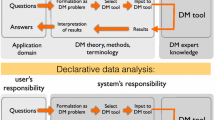Abstract
Motivated by the declarative modeling paradigm for data mining, we report on our experience in modeling and solving relational query and graph mining problems with the IDP system, a variation on the answer set programming paradigm. Using IDP or other ASP-languages for modeling appears to be natural given that they provide rich logical languages for modeling and solving many search problems and that relational query mining (and ILP) is also based on logic. Nevertheless, our results indicate that second order extensions to these languages are necessary for expressing the model as well as for efficient solving, especially for what concerns subsumption testing. We propose such second order extensions and evaluate their potential effectiveness with a number of experiments in subsumption as well as in query mining.
Access this chapter
Tax calculation will be finalised at checkout
Purchases are for personal use only
Similar content being viewed by others
References
De Cat, B.: Separating Knowledge from Computation: An FO(.) Knowledge Base System and its Model Expansion Inference. Ph.D. thesis. KU Leuven
De Cat, B., Bogaerts, B., Bruynooghe, M., Denecker, M.: Predicate Logic as a Modelling Language: The IDP System. In: CoRR abs/1401.6312 (2014)
Erdem, E., Inoue, K., Oetsch, J., Puehrer, J., Tompits, H., Yilmaz, C.: Answer-set programming as a new approach to event-sequence testing. In: International Conference on Advances in System Testing and Validation Lifecycle (2011)
Gebser, M., Kaufmann, B., Neumann, A., Schaub, T.: clasp: a conflict-driven answer set solver. In: Baral, C., Brewka, G., Schlipf, J. (eds.) LPNMR 2007. LNCS (LNAI), vol. 4483, pp. 260–265. Springer, Heidelberg (2007)
Guns, T., Dries, A., Tack, G., Nijssen, S., De Raedt, L.: MiningZinc: a modeling language for constraint-based mining. In: IJCAI (2013)
Guyet, T., Moinard, Y., Quiniou, R.: Using Answer Set Programming forpattern mining. In: CoRR abs/1409.7777 (2014)
Helma, C., Kramer, S.: A survey of the predictive toxicology challenge 2000–2001. Bioinformatics 19(10), 1179–1182 (2003)
Inokuchi, A., Washio, T., Motoda, H.: An apriori-based algorithm for mining frequent substructures from graph data. In: Zighed, D.A., Komorowski, J., Żytkow, J.M. (eds.) PKDD 2000. LNCS (LNAI), vol. 1910, pp. 13–23. Springer, Heidelberg (2000)
Järvisalo, M.: Itemset mining as a challenge application for answer set enumeration. In: Delgrande, J.P., Faber, W. (eds.) LPNMR 2011. LNCS, vol. 6645, pp. 304–310. Springer, Heidelberg (2011)
King, R.D., Srinivasan, A., Dehaspe, L.: Warmr: a data mining tool for chemical data. J. Comput. Aided Mol. Des. 15(2), 173–181 (2001)
Kumar, D.A., de Compadre, L., Rosa, L., Gargi, D., Shusterman Alan, J., Corwin, H.: Structure-activity relationship of mutagenic aromatic and heteroaromatic nitro compounds. Correlation with molecular orbital energies and hydrophobicity. J. Med. Chem. 34(2), 786–797 (1991)
van der Laag, P.R.J., Nienhuys-Cheng, S.-H.: Completeness and properness of refinement operators in inductive logic programming. J. Log. Program. 34(3), 201–225 (1998)
Lehmann, J., Hitzler, P.: Foundations of refinement operators for description logics. In: Blockeel, H., Ramon, J., Shavlik, J., Tadepalli, P. (eds.) ILP 2007. LNCS (LNAI), vol. 4894, pp. 161–174. Springer, Heidelberg (2008)
McCarthy, J.: Elaboration Tolerance (1999)
Muggleton, S., Entailment, I.: Inverse entailment and progol. New Gener. Comput. Spec. Issue Inductive Logic Program. 13(3–4), 245–286 (1995)
Nijssen, S., Kok, J.N.: Efficient frequent query discovery in Farmer. In: Lavrač, N., Gamberger, D., Todorovski, L., Blockeel, H. (eds.) PKDD 2003. LNCS (LNAI), vol. 2838, pp. 350–362. Springer, Heidelberg (2003)
Plotkin, G.D.: A further note on inductive generalization. In: Machine Intelligence, vol. 6, pp. 101–124 (1971)
De Raedt, L.: Logical and Relational Learning: From ILP to MRDM (Cognitive Technologies). Springer-Verlag New York Inc., New York (2008)
De Raedt, L., Ramon, J.: Condensed representations for inductive logic programming. In: KR, pp. 438–446 (2004)
Ray, O.: Nonmonotonic abductive inductive learning. J. Appl. Logic 3, 329–340 (2008)
Rückert, U., Kramer, S.: Optimizing feature sets for structured data. In: Kok, J.N., Koronacki, J., Lopez de Mantaras, R., Matwin, S., Mladenič, D., Skowron, A. (eds.) ECML 2007. LNCS (LNAI), vol. 4701, pp. 716–723. Springer, Heidelberg (2007)
Santos, J., Muggleton, S.: Subsumer: A Prolog theta-subsumption engine. In: ICLP Technical Communications, vol. 7, pp. 172–181 (2010)
Eiter, T., Ianni, G., Krennwallner, T.: Answer set programming: a primer. In: Tessaris, S., Franconi, E., Eiter, T., Gutierrez, C., Handschuh, S., Rousset, M.-C., Schmidt, R.A. (eds.) Reasoning Web. LNCS, vol. 5689, pp. 40–110. Springer, Heidelberg (2009)
Vreeken, J., Leeuwen, M., Siebes, A.: Krimp: mining itemsets that compress. Data Min. Knowl. Discov. 23(1), 169–214 (2011)
Yan, X., Han, J.: gSpan: graph-based substructure pattern mining. In: ICDM (2002)
Author information
Authors and Affiliations
Corresponding author
Editor information
Editors and Affiliations
A Appendix: Introduction to IDP
A Appendix: Introduction to IDP

The IDP language [1, 2] is an extension of first order logic with inductive definitions and aggregration. The IDP system implements finite satisfiability and can be considered as an ASP system.
The particular type of inference we use in our work is model expansion. The task of model expansion is to expand a finite interpretation S for the subvocabulary V of a given logic theory T to a model of T. In the example above, V is the vocabulary of the map colouring problem i.e. area, color, \(\textit{border} (\textit{area},\textit{area})\), \(\textit{coloring}::\textit{area} \mapsto \textit{color} \); S consists of 7 countries, 4 colours and a border relation between the countries; T is the constraint that two bordering countries cannot have the same color.
In this example, the model expansion task is to find an extension of S, i.e. coloring function, such that the constraint in T is satisfied, i.e. all bordering countries have different colours.
The example can be tried online (select file “Map Colouring”):
Rights and permissions
Copyright information
© 2016 Springer International Publishing Switzerland
About this paper
Cite this paper
Paramonov, S., van Leeuwen, M., Denecker, M., De Raedt, L. (2016). An Exercise in Declarative Modeling for Relational Query Mining. In: Inoue, K., Ohwada, H., Yamamoto, A. (eds) Inductive Logic Programming. ILP 2015. Lecture Notes in Computer Science(), vol 9575. Springer, Cham. https://doi.org/10.1007/978-3-319-40566-7_12
Download citation
DOI: https://doi.org/10.1007/978-3-319-40566-7_12
Published:
Publisher Name: Springer, Cham
Print ISBN: 978-3-319-40565-0
Online ISBN: 978-3-319-40566-7
eBook Packages: Computer ScienceComputer Science (R0)




